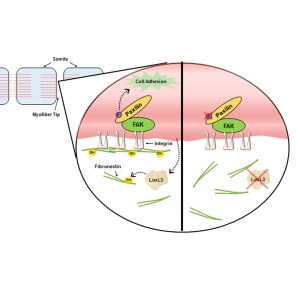Research conducted at the Technion sheds light on the embryonic development of the connection between muscles and tendons, which is essential for the organism's motor activity

Research conducted by Associate Professor Peleg Hasson from the Rappaport Faculty of Medicine at the Technion sheds light on the embryonic development of the muscle-tendon interface, which is essential for the motor activity of the organism. The study was recently published in the journal Developmental Cell.
The ability of the muscle to move the skeleton is a necessary condition for the movement of humans and other vertebrates. Therefore, defects in the aforementioned interface - that is, in the connection between the muscle fibers and the tendon - impair its ability to move. Despite the importance of this interface, and its effect in some cases on degenerative diseases of the muscles, the molecular mechanisms that create it in the stage of embryonic development have not yet been deciphered. Hence the importance of the present study, which sheds light on some essential steps in the aforementioned process.
The anchoring of the muscle fibers at the muscle-tendon interface depends on different pathways of signal transmission, and one of them is the integrin - a receptor that plays an essential role in the connection between cell to cell and between cells to matrix proteins (the intercellular mediator). One of the main factors controlling integrin activity is a protein called fibronectin. In the current study it was found that an enzyme called LoxL3 activates the fibronectin (through oxidation), and subsequently the integrin. LoxL3 is found in high concentration at the ends of the developing muscle fibers, which secrete it during their growth. In a normal state, the secretion of LoxL3 from the muscle fibers increases at the same time as the tendon grows, and as a result, the necessary change (oxidation) occurs in the fibronectin molecule, which activates the integrin. Following the change, the "docking plan" of the muscle fibers is realized at the correct point of interface with the tendon, as can be seen in the left part of the attached diagram.
In pre-clinical experiments, Associate Prof. Hasan discovered that when the LoxL3 enzyme is disrupted, i.e. when a mutation occurs in it, the entire aforementioned chain process goes awry:
(LoxL3 ← fibronectin ← integrin). As a result, the performance of the "docking program" was impaired; The muscle fibers continue to migrate and lengthen excessively and thus "miss" the correct anchoring point. The result: the muscle-tendon interface does not develop properly. The disrupted process can be seen in the right part of the diagram.
Associate Professor Hasson emphasizes that "this is basic research, the clinical consequences of which are still difficult to predict. However, the new discoveries regarding the development of the connection between muscle and tendon may lead to further studies that will paint an even more accurate picture of this critical process."
